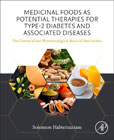
Medicinal Foods as Potential Therapies for Type-2 Diabetes and Associated Diseases: The Chemical and Pharmacological Basis of their Action
Habtemariam, Solomon
Medicinal Foods as Potential Therapies for Type-2 Diabetes: The Chemical and Pharmacological Basis of their Action is the first book to focus on active pharmacological principles that modulate diabetes, associated risk factors, and complications and the mechanism of action of widely used anti-diabetic herbal plants, rather than the nutritional composition of the foods. It provides up-to-date information on the scientific basis of some acclaimed antidiabetic super fruits, species and other food ingredients. The global incidence of diabetes and its major risk factor, obesity, is growing with epidemic proportion, and so there is growing interest in finding new drugs from natural and synthetic sources to help halt this epidemic. The book is divided into six sections: the first part addresses fact and figures of diabetes and obesity at global level. In the second part, the physiological control of carbohydrate and lipid metabolism as well as some common therapeutic targets are presented. In section 3, the pathophysiology of type-2 diabetes and therapeutic options are presented. A dedicated section on super fruits include the therapeutic potential of bilberry and blueberries, bitter melon, okra, prickly pear cactus and other fruits that gain importance as antidiabetic agents in recent years. In section 5, the chemistry and pharmacology of spices including cinnamon, cloves, fenugreek, garlic, ginger and turmeric are presented to outline their antidiabetic potential. The last section includes beverages such as tea, coffee and yerba mate as well as a dedicated chapter on food supplements and other food products with emerging antidiabetic potential. Medicinal Foods as Potential Therapies for Type-2 Diabetes: The Chemical and Pharmacological Basis of their Action is invaluable research scientists and students in medical and pharmaceutical sciences, medicinal chemistry, herbal medicine, drug discovery/development, nutrition science as well as herbal practitioners, industries from the nutraceutical and pharmaceutical areas, and organizations dealing with diabetes and obesity managements Provides background knowledge on type-2 diabetes and its pathophysiology and therapeutic targets at molecular levelExplores in detail the chemistry or secondary metabolites of the indicated foods that potentially modify diabetes and/or associated diseasesExamines the pharmacological findings that attributes to the medicinal foods including available clinical trials INDICE: Section 1 Type-2 Diabetes: Prevalence and significance 1. Type-2 Diabetes: Definition, diagnosis and its significance Section 2 Normal physiological control of carbohydrate and lipid metabolism and some common antidiabetic therapeutic targets 2. Glucose Metabolism: Normal Physiology, Diabetic Dysregulation and Therapeutic Targets 3. Lipid Metabolism: Normal Physiology, dysregulation under Obesity and Diabetes, and Therapeutic Targets Section 3 Pathophysiology of type-2 diabetes and therapeutic options 4. Pathophysiology of type-2 diabetes complications 5. Current phacotherapy options for type-2 diabetes 6. Pharmacological principles of action by plant medicinal foods in type-2 diabetes Section 4. Potential modulators of type-2 diabetes: Super Fruits 7. Bilberry and Blueberries as potential antidiabetic agents 8. The chemistry of Bitter melon (Momordica charantia) and potential antidabetic effects 9. The chemical and pharmacological basis of okra (Abelmoschus esculentus (L.) Moench) as potential antidabetic agent 10. Prickly Pear Cactus and Diabetes 11. Other fruits of growing imnportance as antidiabetic agents Section 5. Potential modulators of type-2 diabetes: Spices 12. The chemical and pharmacological basis of cinnamon as potential antidabetic agent 13. The chemical and pharmacological basis of Fenugreek (Trigonella foenum-graecum linn.) as potential antidiabetic agent 14. The chemical and pharmacological basis of Ginger as potential antidabetic agent 15. The chemical and pharmacological basis of cloves (Syzygium aromaticum) as potential antidabetic agent? 16. The chemical and pharmacological basis of Garlic (Allium sativum L.) as potential antidabetic agent 17. The chemical and pharmacological basis of turmeric (Curcuma longa L.) as potential antidabetic agent Section 6. Potential modulators of type-2 diabetes: Beverages, herbal supplements and other foods 18. The chemical and pharmacological basis of some beverages as potential antidabetic agent 19. Other common foods and herbal Food supplements as antidiabetic agents
- ISBN: 978-0-08-102922-0
- Editorial: Academic Press
- Encuadernacion: Rústica
- Páginas: 612
- Fecha Publicación: 01/09/2019
- Nº Volúmenes: 1
- Idioma: Inglés
